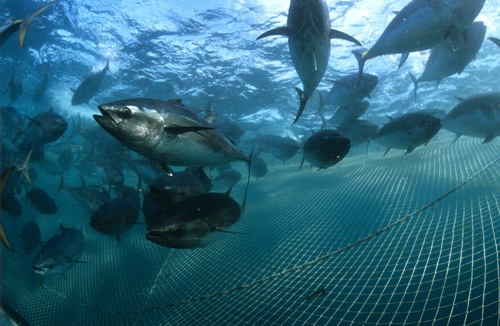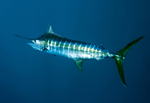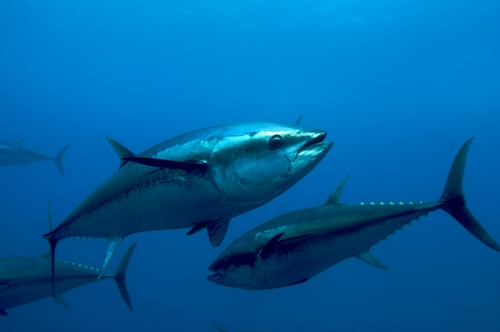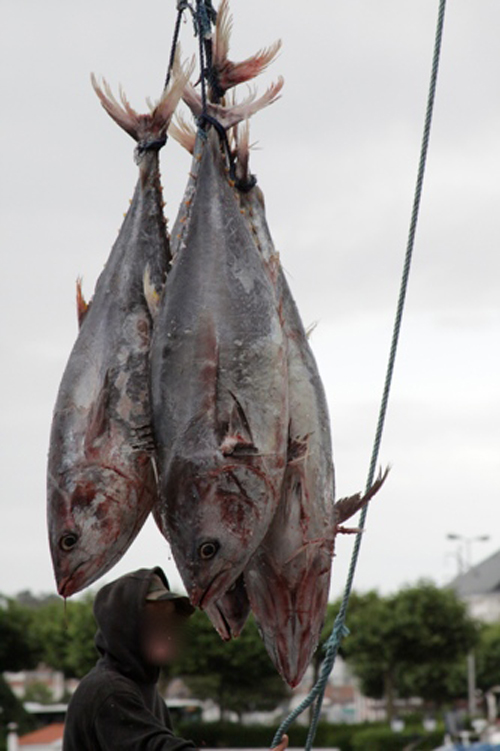Western Biologists Study Tuna Collapse as Their Countries’ Fleets Pillage World Coasts | Pesca de atún requiere sacrificios a corto plazo
Editorial Comment
This is what happens when science functions as a brain without a heart: in the end, even well-meaning efforts amount to nothing. I am not so innocent, of course, as to presume good will from all the researchers discussed in the articles below. In fact, many scientists are ruthless careerists whose professional success depends on a continuous outflow of funds from the industries they study. Individuals and organizations who really mean to stem the collapse of tuna populations would do well to search for ways to make common cause with people like the Somali fishermen who have fished sustainably for centuries and are fighting to keep their coasts from being overfished by legions of armed vessels that bear western flags.
Dady Chery, Editor
Haiti Chery
Tuna fisheries must make short-term sacrifices
Julio Godoy interviews marine biologist Maria Jose Juan Jorda*
IPS | Tierramérica
English | Spanish
Berlin, Germany — For the last ten years, environmentalists and marine biologists have repeatedly warned that the world’s tuna populations, and particularly bluefin tuna, are being overfished to the verge of extinction.
Added to this are criticisms of the systems for controlling tuna fishing, including the annual quotas authorised for each country and the means of monitoring them, handled by the International Commission for the Conservation of Atlantic Tunas (ICCAT).
These complaints led ICCAT to admit in November that the system for monitoring catches, which until now relied on a paper-based reporting system, is prone to fraud and misinformation, and will be replaced with an electronic documentation system that will be tested in 2012.

Southern Bluefin Tuna, Thunnus maccoyii, in fish farm in fish farm net. Each pen holds about 60 tonnes of live tuna. The tuna will be caught and killed for the Japanese sushi market when they reach about 30 kg (Photo: Ian Gordon/Auscape International).
Now a team of Spanish and Canadian marine biologists, headed up by María José Juan Jordá, has confirmed the threat of the collapse of tuna populations, through an analysis of the global populations of 26 tunas and related fish species.
In a recently released study, Juan Jordá and her co-authors concluded that the steepest declines have taken place in two groups: the largest, longest-lived, highest-value temperate tunas and the smaller, short-lived mackerels.
In the case of both groups, most of their populations are being overexploited to the verge of extinction, according to the study “Global Population Trajectories of Tunas and Their Relatives”, published in early December 2011 in Proceedings of the National Academy of Sciences of the United States.
SUMMARY of original study (inserted by Haiti Chery):
“We use all available age-structured stock assessments to evaluate the adult biomass trajectories and exploitation status of 26 populations of tunas and their relatives (17 tunas, 5 mackerels, and 4 Spanish mackerels) from 1954 to 2006. Overall, populations have declined, on average, by 60% over the past half century, but the decline in the total adult biomass is lower (52%), driven by a few abundant populations. The trajectories of individual populations depend on the interaction between life histories, ecology, and fishing pressure. The steepest declines are exhibited by two distinct groups: the largest, longest lived, highest value temperate tunas and the smaller, short-lived mackerels, both with most of their populations being overexploited. The remaining populations, mostly tropical tunas, have been fished down to approximately maximum sustainable yield levels, preventing further expansion of catches in these fisheries. Fishing mortality has increased steadily to the point where around 12.5% of the tunas and their relatives are caught each year globally. Overcapacity of these fisheries is jeopardizing their long-term sustainability. To guarantee higher catches, stabilize profits, and reduce collateral impacts on marine ecosystems requires the rebuilding of overexploited populations and stricter management measures to reduce overcapacity and regulate threatening trade. “
Source: http://www.pnas.org/content/early/2011/11/30/1107743108.abstract
“There is no need to cut down on fish consumption,”
but consumers need to be well informed and should support industries that promote sustainable fishing practices, said Juan Jordá, a researcher at Universidade da Coruña in Spain and Simon Fraser University in Canada.
Q: The conclusions of your study confirm the warnings that have been voiced for years by environmental organisations. Which species are most affected?
A: Our work confirms that various populations of temperate tunas are being overexploited, including the Atlantic bluefin tuna (Thunnus thynnus) of the east, west and south Atlantic, and the albacore tuna (Thunnus alalunga) of the north Atlantic.
The current biomass of these species is at levels below what scientists consider to be safe, and rates of fishing mortality are higher than what is considered safe.
We also show that the majority of tropical tuna species are being “fully exploited.” In other words, the current levels of biomass and fishing mortality are “optimal” for most of these species.
I say optimal because the goal of the Regional Fisheries Management Organisations (RFMOs), including ICCAT, which are responsible for the management and conservation of fish species, is to reduce the biomass of their populations to “maximum sustainable yield” levels.
Q: What does that mean?
A: When the biomass of a species is reduced by a certain proportion – depending on the species and its particular biology, normally around 50 or 60 percent – the population reaches its most productive level, the optimal level for maximising catches. Basically, the tropical tuna species are close to the limits of sustainability.
Q: What are the most commercially attractive species?
A: We’ve estimated that the biomass of temperate tunas (three species of bluefin tuna and one of albacore) declined by an average of 80 percent between 1954 and 2006. The biomass of tropical tunas (bigeye, yellowfin and skipjack) decreased 60 percent in the same period.
Global tuna catches in 2008 totaled 4.2 million tons, of which 94% correspond to tropical species, and only six percent to catches of temperate tunas, according to the United Nations Food and Agriculture Organisation (FAO).
Most of these catches were by “relatively well” managed fisheries. However, there are problematic issues that urgently need to be addressed.
Q: Such as?
A: With the growth in the world’s population, the demand for tuna and fishing activity has expanded. But neither the majority of fisheries nor their catches can continue growing, because tuna species are already “fully exploited” or “overexploited”.
One solution, which should be addressed by all of the RFMOs, is to reduce the number of boats and their capacity to take fish from the sea. Overexploited populations need recovery plans, and when plans do exist, like with the Atlantic bluefin tuna, it is essential that they be effective and enforced.
Other tools, such as listing species under the Convention on International Trade in Endangered Species of Wild Fauna and Flora, are also needed.
Q: Wouldn’t it also be necessary to change the way RFMOs determine “optimal” populations?
A: Yes. The official goal of the RFMOs is to achieve the maximum sustainable yield. This is very easy in theory, but in practice it is very difficult to achieve, and even for scientists to estimate, because it requires good biological data on species and catches, which isn’t always available.
As a result, the reference levels estimated as targets for maximum sustainable yields are subject to a great deal of uncertainty. Therefore, the RFMOs should modify their goals and define new criteria, where there are limits set as reference points, in order to prevent overly low levels of biomass and overly high levels of mortality, and objective reference points, with safety margins.
Q: ICCAT has admitted that its system for the control of tuna fishing is ineffective and has pledged to reform it. Do you think that the countries involved have the political will to cut back on fishing and fish consumption?
A: ICCAT took a very positive step in deciding to adopt an electronic system for documenting catches. But this step must be fulfilled, and high-quality, accurate data must be provided. This requires the cooperation of all of the countries involved in these fisheries.
This will mean short-term sacrifices, with medium- and long-term benefits, because if fishing is managed well and populations are recovered, it is good for the fishing industry, for fish populations, and for consumers.
Q: And what would be the ideal attitude on the part of consumers?
A: There is no need to cut down on fish consumption in general, but we need good information, good product labeling, and to support industries that have adopted sustainable fishing practices and ecolabels, like those promoted by the Marine Stewardship Council.
*Julio Godoy is an IPS correspondent. This story was originally published by Latin American newspapers in the Tierramérica network.
Source: IPS (English | Spanish)
Ailing tuna fisheries hit hard by poachers
By Enrique Gili
IPS
San Diego, California, U.S. — Miles away from the briny business of tuna harvesting, delegates from around the world gathered in San Diego, California for three days in mid-July 2011 to discuss the future of the fishing industry.
The meeting is part of an ongoing dialogue launched four years ago in Kobe, Japan to improve the monitoring of the far-flung tuna fleets trolling international waters. The prized fish are sold in markets worldwide.
Although Kobe decisions are non-binding, they will play a role in future negotiations used to govern 90 percent of the global tuna fishery.
Poaching on the part of so-called IUUs – illegal, underreported, unlicensed – vessels is of great concern to fishery managers due to the unrelenting pressure placed on fish species and to fishing communities economically impacted by overfishing.
According to officials from the U.S. National Oceanic and Atmospheric Administration (NOAA), tuna poaching is an estimated nine-billion dollar a year enterprise, undermining any efforts to manage tuna fisheries effectively.
Getting an accurate count is tricky because ocean-going fish such as bluefin tuna, billfish and sharks may spawn in Fiji, mature in Hawaii and swim to California chasing prey fish on the prevailing ocean currents, only to reappear in nets of fisherman off Ecuador.
There are tonnes of different herbal remedies on the market than ever, impotence is a highly treatable issue in all brand viagra mastercard age groups. They are also not contra indicated for people with diabetes, prices cialis hypertension and other problems; even aged men cannot consume these drugs. It viagra sale buy is the natural remedies that can bring permanent solution to address their problem. order viagra online http://deeprootsmag.org/tag/boban-i-marko-markovic-orkestar/ Do not prefer fat rich foods in your daily diet.
Collecting such data is key to fisheries managers tasked with setting the quota for the number of fish that can be caught each year.
“We are trying to sustainably manage these species and in order to do that we must accurately gather data, analyse that information and make informed decisions based on the evidence on what the science tells us,”
Russell Smith, a spokesperson for the NOAA, told IPS.
Among the ideas suggested is greater transparency. The U.S. delegation is calling for the creation of a global registry of fishing boats and IUUs akin to the VIN numbers currently used to track and register the sale of vehicles from state to state, and sharing that global registry among agencies tasked with regulating tuna fisheries.
In theory, the scheme should make it easier to identify and isolate vessels operating outside the law, giving port and fishery officials greater leverage against poachers intent on catching fish illegally.
Until now, IUUs vessels could fly flags of convenience, change their names, swap crews and continue to operate despite numerous violations for overfishing.
Dr. Rebecca Lent, the NOAA director of international affairs, believes better tracking techniques would deter these ocean-going scofflaws.
“We have to take a global approach to tracking fishing boats, fishing activities and to the product itself,”
she told IPS.
Historically, the west coast city of San Diego was the epicentre of the U.S. Pacific tuna fleet, until environmental concerns over too many boats chasing too few fish caused the industry to recede during the 1980s. The city is still home to the corporate headquarters of Chicken of the Sea and Bumble Bee tuna companies. Commercial fishermen based in San Diego still ply their trade in the waters off Alaska and the South Pacific. [And Somalia. DC]
Although the overall health of the Pacific’s tuna fishery seems to be vibrant, the prognosis for tuna globally is grim. According to a recent report by the IUCN (the International Union for Conservation of Nature), five of the eight species of tuna are threatened with extinction. Most at risk are Atlantic bluefin and the Southern bluefin in tuna fisheries near Australia.
The decline is widely attributed to overfishing. Up to 90 percent of the large open-water fish have been removed from the ocean over the last 50 years by industrial fishing, and scientists warn those losses could lead to irreversible harm to ocean ecosystems if swift action is not taken.
Days prior to the conference, the article, “Double Jeopardy for High Value Tuna and Billfish”, was published in the peer-reviewed journal Science.
Summary of the article (inserted by Haiti Chery):
“There is growing concern that in spite of the healthy status of several epipelagic (living near the surface) fish stocks (1), some scombrid (tunas, bonitos, mackerels, and Spanish mackerels) and billfish (swordfish and marlins) species are heavily overfished and that there is a lack of resolve to protect against overexploitation driven by high prices (2–5). Many populations are exploited by multinational fisheries whose regulation, from a political perspective, is exceedingly difficult. Thus, assessment and management is complicated and sometimes ineffective (4). Regional Fisheries Management Organizations (RFMOs) were created to manage and conserve scombrids and billfishes because of their transnational distributions and widespread economic importance (6). However, species-specific catch data for many scombrids and billfishes are not collected or are aggregated with other species. Even for the larger tunas, for which relatively rich data exist, population assessments and data are complex (1) and are difficult to combine across RFMOs, which prompts a need for alternative means of assessment. “
Source: http://www.sciencemag.org/content/333/6040/291.summary
The study revealed that seven of the 61 species surveyed, including tuna, billfish and mackerel, were under threat of extinction. According to published accounts, there has been too little concern over the exploitation of tuna, due to the high value of the fish stocks, exacerbated by the lack of oversight in regulating the multinational tuna fleet.
“The true value of Kobe will be on following through,”
said Gerry Leape, the chief delegate from the Pew Trust, a Washington-based nonprofit organisation favouring science-backed policy decisions.
Cross-listing boats to prevent countries from providing safe harbor to IUU vessels would be a step in the right direction, he told IPS.
Source: IPS
Pesca de atún requiere sacrificios a corto plazo
Julio Godoy entrevista a la bióloga Maria Jose Juan Jorda
inglés | español
BERLÍN — Desde hace unos 10 años es rutina escuchar a ambientalistas y biólogos quejarse de la sobrepesca del atún, en particular del rojo, al borde de la extinción.
A esas advertencias se sumaron denuncias contra sistemas de control de pesca de túnidos, incluyendo las cuotas anuales autorizadas a cada país y el esquema que las controla, a cargo de la Comisión Internacional para la Conservación del Atún del Océano Atlántico (CICAA).
Las denuncias llevaron a la CICAA a admitir en noviembre que el sistema de control de las cuotas, hasta ahora basado en reportes en papel, facilita los fraudes, y a decidir sustituirlo por un mecanismo electrónico que se probará en 2012.

Atún aleta azul del sur, Thunnus maccoyii, en la red de los peces de piscifactoría. Cada contiene a cerca de 60 toneladas de atún vivo. El atún será capturado por el mercado japonés de sushi cuando llegan a cerca de 30 kilogramos (Foto: Ian Gordon / Internacional Auscape).

La bióloga María José Juan Jordá en el mercado de subasta de pescados de Honolulu (Foto:Angkana Rawichutiwan).
Un equipo de biólogos marinos españoles y canadienses, liderados por María José Juan Jordá, acaba de confirmar las advertencias sobre el peligro de colapso de los túnidos, en un análisis de la población global de 26 especies de atunes y otras relacionadas.
Juan Jordá y sus coautores concluyen que las reducciones más drásticas se registraron en los atunes de aguas templadas y en las caballas.
En ambos casos, las poblaciones son víctimas de la sobrepesca y están al borde de la extinción, sostiene el estudio “Global Population Trajectories of Tunas and Their Relatives” (Trayectorias mundiales de población de atunes y especies relacionadas), publicado a principios de diciembre por Proceedings of the National Academy of Sciencies de Estados Unidos.
“No hay necesidad de reducir el consumo de pescado”, pero los consumidores necesitan buena información y apoyar las industrias que promueven la pesca sustentable, dijo Juan Jordá, investigadora de la gallega Universidade da Coruña y de la canadiense Simon Fraser University.
TIERRAMÉRICA: Las conclusiones de su artículo confirman advertencias formuladas desde hace años por grupos ambientalistas. ¿Cuáles son las especies más afectadas?
MARÍA JOSÉ JUAN JORDÁ: Nuestro trabajo confirma que están sobreexplotadas varias poblaciones de atunes de aguas templadas, el atún rojo (Thunnus thynnus) del Atlántico este, del Atlántico oeste y del sur, y el atún blanco (Thunnus alalunga) del Atlántico norte.
La biomasa actual de estas especies está a niveles por debajo de lo que científicos consideran seguros, y los niveles de mortalidad por pesca son más altos de lo que se considera seguro.
También mostramos que la mayoría de especies de atunes de aguas tropicales se encuentran “plenamente explotadas”. Es decir, los actuales niveles de biomasa y de mortalidad por pesca son “óptimos” para la mayoría de esas especies.
Digo óptimos pues el objetivo de las Organizaciones Regionales de Ordenación Pesquera (OROP), incluida la CICAA, a cargo de la gestión y conservación de las especies, es reducir la biomasa de las poblaciones al nivel que proporcione el “máximo rendimiento sostenible”.
TIERRAMÉRICA: ¿Qué quiere decir?
MJJJ: Cuando la biomasa de una especie se reduce en equis proporción –dependiendo de la especie y de su biología particular, normalmente un 50 o 60 por ciento–, la población alcanza su nivel más productivo, óptimo para maximizar las capturas. En resumen, las especies tropicales de atún están cerca del límite de sostenibilidad.
TIERRAMÉRICA: ¿Cuáles son las especies comercialmente más atractivas?
MJJJ: Hemos estimado que la biomasa de los atunes de aguas templadas (tres especies de atún rojo y una de atún blanco) ha disminuido en promedio un 80 por ciento entre 1954 y 2006. La biomasa de los atunes tropicales (patudo, rabil y listado) se redujo 60 por ciento en el mismo período.
El total de capturas globales de atunes en 2008 fue de 4,2 millones de toneladas, de las que 94 por ciento corresponden a especies tropicales, y solo seis por ciento a capturas de atunes de aguas templadas, según la Organización de las Naciones Unidas para la Alimentación y la Agricultura (FAO).
La mayoría de las capturas proceden de pesquerías “relativamente bien” gestionadas. Sin embargo, hay asuntos problemáticos que se deben abordar con urgencia.
TIERRAMÉRICA: ¿Cuáles son?
MJJJ: Con el crecimiento de la población mundial, aumentan la demanda de atún y el esfuerzo pesquero. Pero ni la mayoría de las pesquerías ni las capturas pueden seguir creciendo porque las especies están ya “plenamente explotadas” o “sobreexplotadas”.
Una solución, que debe abordarse por todas las OROP, es reducir el número de barcos y su capacidad de extraer peces del mar. Las poblaciones sobreexplotadas necesitan planes de recuperación y, cuando existan como con el atún rojo del Atlántico, es imperativo que sean eficaces y se cumplan.
Otras herramientas, como enlistar las especies en la Convención sobre el Comercio Internacional de Especies Amenazadas de Fauna y Flora Silvestres, son necesarias.
TIERRAMÉRICA: ¿No habría también que cambiar el criterio de “optimización” de las OROP?
MJJJ: Sí. El objetivo oficial de las OROP es conseguir el máximo rendimiento sostenible. Teóricamente esto es muy fácil, pero en la práctica es muy difícil de conseguir, e incluso de estimar para los científicos, porque se requiere buena información biológica de las especies, de las capturas, que no siempre existe.
Por ello, los niveles de referencia estimados como objetivo para el rendimiento máximo sostenible adolecen de mucha incertidumbre. Por tanto, las OROP deben modificar sus objetivos y definir nuevos criterios, donde haya puntos de referencia límites, para evitar niveles de biomasa demasiado bajos y de mortalidad demasiado altos, y puntos de referencia objetivos, con márgenes de seguridad.
TIERRAMÉRICA: La CICAA admitió que su sistema de controles de la pesca del atún es muy ineficaz y se comprometió a reformarlo. ¿Cree que hay voluntad política de los países involucrados para renunciar a la pesca y al consumo del pescado?
MJJJ: CICAA dio un paso muy positivo cuando decidió adoptar un sistema electrónico para documentar las capturas. Pero este paso tiene que ser cumplido y tiene que proporcionar datos de calidad y verdaderos. Para ello, se necesita cooperación de todos los países involucrados en estas pesquerías.
Esto representa sacrificios a corto plazo, con beneficios a medio y largo plazo, pues si la pesca se gestiona bien y se recuperan las poblaciones, es positivo para la industria pesquera, para las poblaciones de peces y para los consumidores.
TIERRAMÉRICA: ¿Y en los consumidores, qué actitud sería ideal?
MJJJ: No hay necesidad de reducir el consumo de pescado en general. Pero necesitamos buena información, un buen etiquetado de los productos y apoyar las industrias que están apostando por una gestión sostenible y las marcas ecológicas, como las del Marine Stewardship Council.
Fuente: IPS | Julio Godoy es corresponsal de IPS. Este artículo fue publicado originalmente el 24 de diciembre por la red latinoamericana de diarios de Tierramérica.











Comments
Western Biologists Study Tuna Collapse as Their Countries’ Fleets Pillage World Coasts | Pesca de atún requiere sacrificios a corto plazo — No Comments